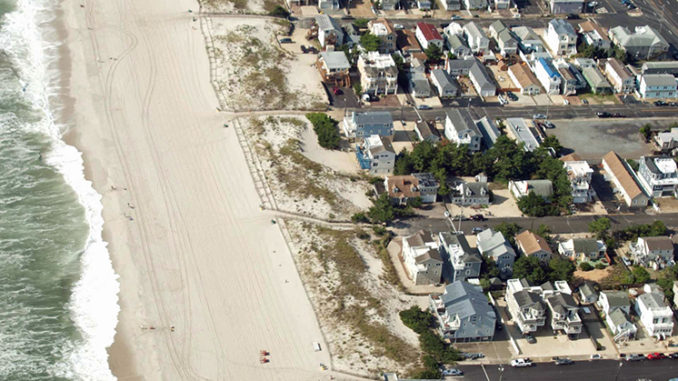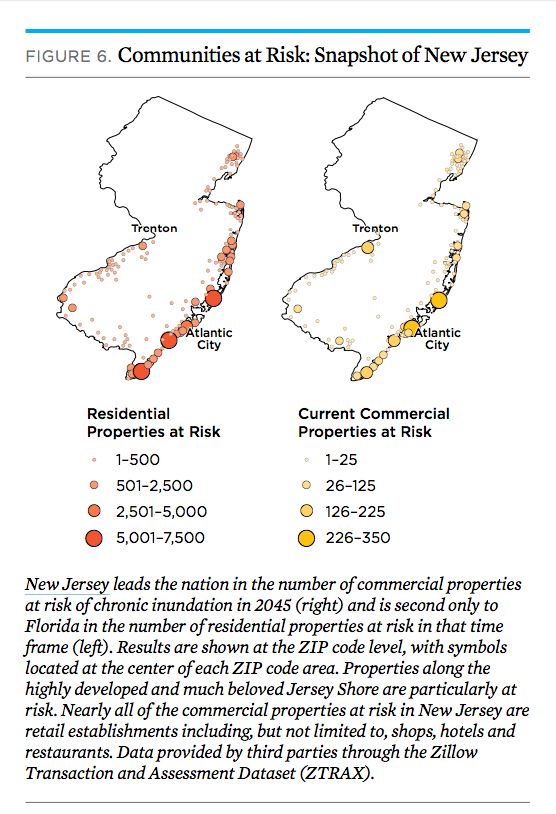
NEW JERSEY—Sea levels in New Jersey could rise from 2000 levels by as much as 1.1 feet by 2030, 2.1 feet by 2050 and 6.3 feet by 2100, according to a new study released during the first meeting of New Jersey’s new Interagency Council on Climate Resilience.
The study, “The Rising Seas and Changing Coastal Storms,” was commissioned by the New Jersey Department of Environmental Protection (NJDEP) and prepared by Rutgers University and leading climate change experts. The report also concludes sea-level rise projections in New Jersey are more than two times the global average, according to NJDEP.
“New Jersey has much to lose if we do not act quickly and decisively to adapt to the realities of climate change,” NJDEP Commissioner Catherine R. McCabe.
‘Particularly susceptible’
New Jersey is particularly susceptible to the impacts of rising oceans due to its geological location and composition. As its land mass was built up by erosion after the ice age, New Jersey’s large coastal plain was made up of loose sediments which has been undergoing long-term natural sinking of land through subsidence. The state’s latitudinal position in relation to the bulging of oceans caused by the earth’s rotation (there is more bulging as you get closer to the equator), ocean circulation patterns and other factors, puts it at rick for rising sea levels exacerbated by the expansion of the ocean caused by melting glaciers and ice sheets.
This last factor, the loss of ice, is a result of global warming, a human induced stress. Global warming results from an overload of greenhouse gases in the atmosphere, in particular, carbon dioxide, from industrial and motor vehicle emissions. In simple physics, melting ice creates more water and when water warms up it expands.
Over the last 40 years, sea-level rose an average of 0.2 inches per year along the state’s coast, compared to a global average of 0.1 inch per year. The study also notes that the frequency of routine tidal flooding not associated with specific storms has increased, from an average of less than one event in Atlantic City between 1950 and 1960 to an average of eight events per year between 2007 and 2016—and a high of 18 events in 2009. By 2100, high-tide cycle flooding could become a regular occurrence, at 240 days per year.
As part of its evaluation, Rutgers determined that sea-level from 1911 (the beginning of tide-gauge record-keeping) at Atlantic City has risen 17.6 inches, compared to 7.6 inches globally. Moreover, sea-level has risen 8.2 inches over the past 40 years at Atlantic City, compared to an average 4.3 inches globally.
At this rate, an analysis by Zillow Real Estate predicts more than 40 New Jersey towns are at risk of being more than 50 percent underwater. New Jersey leads the nation in the number of commercial properties at risk of chronic inundation in 2045 and is second only to Florida in the number of residential properties at risk in that time frame, according to a study by the Union of Concerned Scientists, which drew from the Zillow data.

Interagency Council on Climate Resilience’s first meeting
The results of the NJDEP study were released during the Interagency Council on Climate Resilience’s first meeting, Dec. 12, 2019.
The council, comprised of representatives from 17 state agencies and chaired by the governor’s office, was formed by Gov. Phil Murphy’s recent Executive Order 89 that was signed in October 2019, on the seventh anniversary of Superstorm Sandy. The order commits the state to developing and implementing a statewide climate resilience strategy. The meeting was held at NJDEP headquarters in Trenton. The Council will serve to facilitate a whole-of-government response to the climate crisis.
“New Jersey is extremely vulnerable to the impacts of climate change and we must work together to be more resilient against a rising sea and future storms,” said Murphy. “The data presented in this report will not only guide the Interagency Council’s decisions, but will also advise future generations of leaders on how to best mitigate the devastating effects of climate change.”
The lead author of the Rutgers report, Robert E. Kopp, associate professor and director of Rutgers Institute of Earth, Ocean, and Atmospheric Sciences said, “Sea-level rise drives some of the greatest hazards New Jersey faces from climate change. Building upon three years of on-the-ground experience since the release of Rutgers’ first Science and Technical Advisory Panel sea level assessment, which was conducted for the New Jersey Climate Change Alliance, this report presents the state of the scientific understanding of sea level rise and changing coastal storms in a form designed to support state and local efforts to protect New Jersey’s coastal communities.”
You can read the full report here.
The Murphy Administration has made addressing climate change a priority for the state. Murphy joined the U.S. Climate Alliance, a bipartisan coalition of states committed to the Paris Climate Treaty goals in the absence of federal leadership and precipitated by the Trump Administration’s decision to remove the U.S. from the international Paris accord.
New Jersey has also re-entered the Regional Greenhouse Gas Initiative, which works to reduce emissions of greenhouse gases from the energy sector. The state also is working on initiatives to reduce emissions from vehicles, which account for more than 40% of New Jersey’s greenhouse gas emission.
The Administration has also launched various initiatives to make coastal and urban areas more resilient to flooding and sea-level rise and has been providing planning tools to assist local governments.
Hillary Viders, Ph.D. is the author of “Marine Conservation for the 21st Century.” She has consulted with NOAA on climate change and was a member of Vice President Al Gore’s committee on global warming in Washington D.C. in the 1990s.
